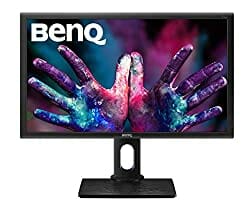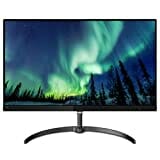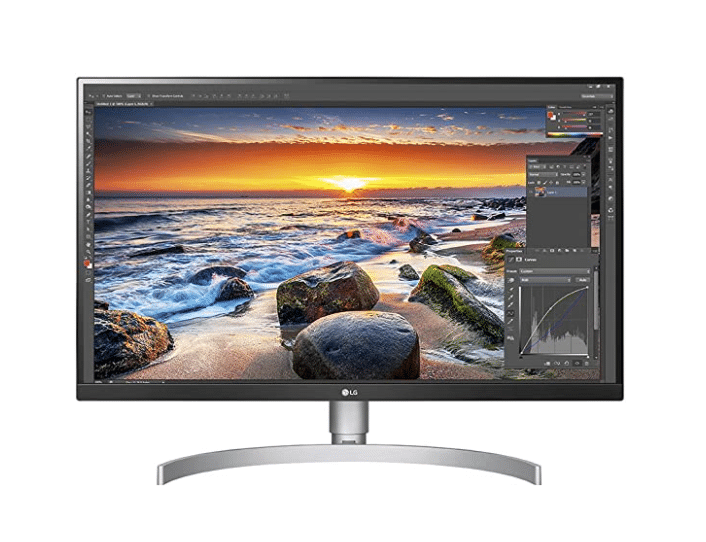7 Top Picks
4 Reviewers
30 Hours of Research
30 Options Considered
No matter which brand you choose or what budget monitor you have, the best monitor for architects should be a monitor that can display and produce maximum color, brightness, and contrast of images accurately as they are intended. If you’re on a hunt for highest resolution computer monitors for your architecture or design work, then this guide should help you pick the best one to do the job for you. We reviewed general purpose work monitors here.
7 Top PC Monitors
[Best Overall]
As architects with constant design projects, upgrading to an HDR10-compatible IPS 4k screen ensures that you get to see and deliver accurate colors at all times.
5.0/5
[Best for the Money]
Just like LG’s 29WK600-W 29-inch IPS monitor with a resolution of 2560x1080 pixels. It comes without any screen bezels in the way, so the 29 inches feels so much larger than it is.
4.9/5
[Best for the Design]
Since you’d be able to see even the fine details, the BenQ PD2700U monitor can be a perfect tool for working on visual effects, smooth graphics,
4.8/5
This monitor is a two-toned display with an all-black front and all-white back panel and stand. As an ultrawide screen with IPS display, expect to have a modern, suave and thoughtful design with fairly thin bezels at the sides and top.
4.7/5
It looks super sleek design with its all-black, front-and-back panel with a silver back tilt stand to minimize fingerprint marks. This monitor is super-flexible – you can adjust its height, tilt, swivel, or pivot if you want to.
4.6/5
I like that the I/O connections are all facing downwards – users can easily plug into three USB 2.0 ports, an audio output, an HDMI input, and two Display Port inputs.
4.5/5
The Philipps 276E8VJSB uses 60-hertz IPS-style panel with a high resolution of 3840 x 2160 pixels that supports 10-bits per subpixel color output via 8-bit + FRC dithering.
4.4/5
Picking the Best Monitor for Architects
Like shopping for any kind of monitor, there is no single architect display for ALL architects. There are some guidelines about the minimum specifications you’d need to take note of, but the screen size and special features would vary based on your budget and on a case-to-case basis. We narrowed it down for you if you are looking for the best monitor for CAD.
How to Choose a Monitor for Architects
Learning about the image quality and accuracy and resolution architects, designers, and creatives need are important considerations, especially if you’re studying any of these fields.
General-use monitors are designed for basic computing, Word processing, and light gaming. Unfortunately, these won’t be enough. The best monitor for design and architecture should have better color performance, resolution, eye care technologies and type of panel than general-use monitors.
Best Monitor for Architects Reviews
If you don’t have time window-shopping and just want to find out which the best monitor for architects is, then read through these 7 monitors I handpicked for this field:
[Best Monitor Overall]
5/5
As architects with constant design projects, upgrading to an HDR10-compatible IPS 4k screen ensures that you get to see and deliver accurate color spaces at all times, providing stunning viewing experience. What’s good about the LG 27UK850-W monitor is that the images you work on will be delivered in full HD resolution even when you’re viewing off-angle, giving you a visually immersive experience. We reviewed 40" with 4K resolution monitors separately.
LG 27UK850-W 4K UHD IPS Monitor Specifications
Panel Type | LED-backlit LCD monitor / TFT active matrix |
Aspect Ratio | 16:9 |
Max. Resolution | 3840 x 2160 pixels |
Brightness | 450 cd/m² |
Contrast Ratio | 1000:1 |
Screen Size | 27 inches |
Refresh Rate | 60 hertz |
Item dimensions | 24.1 x 9.2 x 22 inches |
Weight | 13.40 pounds |
This HD IPS Led LIT monitor with IPS display technology supports 10-bit color depth and covers 99% of the sRGB color space. Creatives would love that the 178-degree viewing angle provides maximum space for both work and entertainment. Plus, LG added eye care technologies like integrated blue light filter, low-blue lights and flicker free technology features into its 27UK850-W monitor that protects eyes.
The LG 27UK850-W is a virtually-borderless display thanks to the super-thin bezel designed on three sides. Users can easily adjust the display’s sleek silver ArcLine stand by height, tilt or pivot. The sturdy and adjustable stand was designed with a smooth curve that ensures stability and a ton of style.

A welcome productivity feature is the on screen control, which lets you access brightness, Screen Split 2.0, picture mode presets, Dual Controller, and other quick settings. The height and wide viewing angle of this monitor are adjusted easily.
As for connections, this LG monitor includes two HDMI 2.0 ports for multi monitor setups, allowing smooth multi tasking, as well as USB Type-C ports, dual USB 3.0, and headphone jacks for various devices.
Even if heavy gamers would say this LG 27UK850-W monitor has slow refresh rates (this has 60 hertz), this can still display sufficient graphics for most games although gaming is not the intended purpose. It's architectural work.
LG 27UK850-W 4K UHD IPS Monitor Pros
LG 27UK850-W 4K UHD IPS Monitor Cons
[Best For The Money]
4.9/5
Ultrawide monitors are awesome for creatives because the extra work space allows for maximum viewing at all angles possible, allowing comfortable viewing. Just like LG’s 29WK600-W 29-inch IPS monitor with a resolution of 2560x1080 pixels. It comes without any screen bezels in the way, so the 29 inches feels so much larger than it is.
LG 27UK850-W 4K UHD IPS Monitor Specifications
Panel Type | IPS LCD |
Aspect Ratio | 16:9 |
Max. Resolution | 2560 x 1080 pixels |
Brightness | 300 cd/m² |
Contrast Ratio | 1000:1 |
Screen Size | 29 inches |
Refresh Rate | 75 hertz |
Item dimensions | 27.50 x 8.20 x 16.20 inches |
Weight | 11.50 pounds |
Setting up this HD monitor display is straightforward. If you always hated the black plastic that attracts fingerprints non-stop, you’d be happy with the LG’s matte white back panel even if the plastic feels flimsy while setting it up. It does begin to feel sturdy once you’ve connected the stand with the display.
The on-screen display and joystick allows you to navigate the menu and settings pretty quickly. You can adjust brightness, picture modes, and other image processing settings.

The strengths of LG 29WK600-W include the:
- LG screen split software – LG designed this display with productivity in mind and you can see it with the included screen-split software.
- Picture quality and accuracy – Because this monitor is an IPS panel, you can expect to work images with accurate color no matter which angle you’re viewing it from.
- High Dynamic Range – This is an amazing feature for modern monitors, but may be dependent on your graphics settings. Having HDD expands the contrasts and colors of an image resulting in a more vivid and real-looking clear image quality, without color distortion.
The built in speakers can be weak, but still a good addition.
LG 29WK600-W UltraWide IPS Monitor Pros
LG 29WK600-W UltraWide IPS Monitor Cons
[Best For The Design]
4.8/5
BenQ advertised this monitor as one made for designers. With 4K UHD resolution and BenQ’s AQCOLOR technology, the colors you work on and view on this monitor is accurately as they are intended to provide extra sharp images details. Since you’d be able to see even the fine details, the BenQ PD2700U monitor can be a perfect tool for working on visual effects or video editors, graphics, animation, videos and photos.
BenQ PD2700U 27-inch 4K Monitor for Designers Specifications
Panel Type | IPS LCD with LED backlight |
Aspect Ratio | 16:9 |
Max. Resolution | 3840x2160 pixels |
Brightness | 350 cd/m2 |
Contrast Ratio | 1300:1 |
Screen Size | 27 inches |
Refresh Rate | 60 hertz |
Item dimensions | 14.49 x 9.06 x 24.50 inches |
Weight | 16.96 pounds |
The BenQ PD2700U gives users access to a billion colors via the 10-bit tech. You also get to enjoy a CalMAN-verified and Pantone-validated monitor, which means it has been pre-calibrated and you get to use this perfect monitor straight out of the box.
In fact, BenQ equipped this monitor with special functions like Dual View mode (so you could split screens anytime), CAD/CAM mode, Animation mode and Darkroom, so you could get down to the tiniest details with ease.

BenQ also included every eye care technology they could add to the PD2700U, such as auto-adjust light to ambient light and eye saver mode, so you can use the monitor comfortably even during long periods of use. It also offers energy saving mode, as well as auto sleep mode.
This computer monitor targets the freelance artist or architect student starting out in the world of design. There are still many better monitors for graphic designers, but the PD2700U is a pretty competitive display quality with a lot to offer for its price.
BenQ PD2700U 27-inch 4K Monitor for Designers Pros
BenQ PD2700U 27-inch 4K Monitor for Designers Cons
The LG 34WK650-W monitor is a two-toned display with an all-black front and all-white back panel and stand. As an ultrawide screen with IPS display, expect to have a modern, suave and thoughtful design with fairly thin bezels at the sides and top. There are 100x100mm holes readily available for VESA mount and if you’re not planning to mount the display, you can make monitor height adjustments up to 110mm and tilt it by -5 to 15 degrees.
34-inch LG 34WK650-W UltraWide IPS Display Specifications
Panel Type | IPS LCD |
Aspect Ratio | 21:9 |
Max. Resolution | 2560 x 1080 pixels |
Brightness | 300 cd/m2 |
Contrast Ratio | 1000:1 |
Screen Size | 34 inches |
Refresh Rate | 75 hertz |
Item dimensions | 32.50 x 9.10 x 22.50 inches |
Weight | 16.80 pounds |
Check the back and you’d see one Display Port input, two HDMI ports, a headphones jack, and two 5W built-in MaxxAudio speakers. What isn’t visible, but a welcome addition, are the anti-glare 3H treatment coating that eliminates unwanted light reflections.
This great monitor also has an On-Screen Display menu, which makes life easier if you’re on your computer designing architecture projects for long hours daily.
One major thing you should consider is that the LG 34WK650-W monitor has 81 PPI (pixels-per-inch), which can be blurry on small texts if you’re going to be writing a lot on your computer. For design and light gaming, this low pixel density shouldn’t be an issue.

When it comes to impeccable performance, the LG 34WK650-W is just as much a graphic designer’s dream (because of its super-accurate, extremely vibrant colors and vivid visuals) as it is a gamer’s dream monitor (because of its anti-ghosting and improved refresh rate. The extra bump from 60 to 75 Hertz when using a DisplayPort cable is very much appreciated.
However, don’t expect much from the built in speakers as they don’t really contribute anything good for this beautifully-crafted value-for-money LG monitor.
34-inch LG 34WK650-W UltraWide IPS Display Pros
34-inch LG 34WK650-W UltraWide IPS Display Cons
What the ViewSonic VP2768 PRO lacks in larger screen size, it makes up for the exceptionally vibrant and accurate color and grayscale, as well as unique features you rarely get to see at this price point.
ViewSonic 27-inch VP2768 PRO Monitor Specifications
Panel Type | SuperClear IPS LED |
Aspect Ratio | 16:9 |
Max. Resolution | 2560 x 1440 pixels |
Brightness | 350 cd/m2 |
Contrast Ratio | 950:1 |
Screen Size | 27 inches |
Refresh Rate | 60 hertz |
Item dimensions | 8.50 x 24.10 x 21.30 inches |
Weight | 15.20 pounds |
The ViewSonic VP2768 PRO looks super sleek design with its all-black, front-and-back panel with a silver back tilt stand to minimize fingerprint marks. This monitor is super-flexible – you can adjust its height, tilt, swivel, or pivot if you want to. For a more permanent wall mounting, there are VESA-compliant holes at the back and a cable holder. There are also a lot of connectivity options, such as a USB type C port connectivity.
The I/O ports at the back are arranged so elegantly. Facing downward, you have options for two HDMI inputs, two DisplayPort inputs, 1 DisplayPort output, 1 USB upstream port and 4 USB downstream ports, and an audio output. Even the power switch and 5 quick-access menu buttons are lined up at the back in a modern way.

For those in design, architecture and other creative/arts fields, the ViewSonic VP2768 PRO, with it's great screen space, should be able to accommodate your needs of precise, highly-detailed imagery with accurate grayscale reproduction and perfect viewing angles no matter where you look. You'll be able to see incredible details without dead pixels and random flickering.
This high performance monitor also has the 6-Axis Color Enhancement function and hardware calibration system that helps you auto-tune and individually-adjust the six primary colors: magenta, red, yellow, blue, green and cyan. It also shows on-screen motion clearly and smoothly with less motion blur.
ViewSonic 27-inch VP2768 PRO Monitor Pros
ViewSonic 27-inch VP2768 PRO Monitor Cons
4.5/5
If you’re on a budget, but require a monitor that would let you work on accurate grays, darks, bright lights and colors, check out the mid-priced 27-inch BenQ PD2700Q display.
BenQ PD2700Q 27-inch IPS Display Specifications
Panel Type | IPS LED |
Aspect Ratio | 16:9 |
Max. Resolution | 2560x1440 pixels |
Brightness | 350 cd/m2 |
Contrast Ratio | 1000:1 |
Screen Size | 27 inches |
Refresh Rate | 60 hertz |
Item dimensions | 9.44 x 25.24 x 16.43 inches |
Weight | 15.20 pounds |
What’s good about this BenQ monitor is that even if it is one of the lowest priced in this list, the display doesn’t feel cheap. The cabinet is simple, but its screen is still non-reflective, framed by 0.75-inch bezels. The rectangular stand may look old school, but it is definitely sturdy and can be height adjusted, swiveled, pivoted and tilted if the need arises.
I like that the I/O connections are all facing downwards – users can easily plug into three USB 2.0 ports, an audio output, an HDMI input, and two Display Port inputs.

For an old model, the 2k world class display and its 2560×1440 QHD resolution, 100% sRGB and 178-degree easy wide viewing angle which delivers amazing sharp and crisp images viewing experience, that is quite good for professional use. Color reproduction is true-to-life and vibrant just like higher-priced PC monitors.
It also has other features such as changing the color temperature by choosing cooler or warmer tones, or set it so it automatically adjusts and remain consistent while working.
One important feature that might strike creative users is the Darkroom Mode, which gives you more settings for contrast, brightness and other image adjustments. There is also the CAD/CAM mode for upgraded 3D color and lines.
If you’re going to use this sophisticated monitor for long periods, you’d benefit from the DualView function that lets you split your screen space for maximum productivity. You can also stop worrying about potential eye strain during long working sessions since this particular crisp and clear images & display is designed with anti-flicker and balanced backlighting.
BenQ PD2700Q 27-inch IPS Display Pros
BenQ PD2700Q 27-inch IPS Display Cons
We included this Philipps 276E8VJSB monitor with this list because it is one of the cheapest 4k Ultra high-definition IPS monitors in the market today. There are a couple of sacrifices done to lower the price tag, but if you’re only after vibrant, accurately-colored and consistently good images that most 4k IPS monitors offer, then you’d love this model.
Philips 276E8VJSB 4K UHD IPS Display Specifications
Panel Type | LED |
Aspect Ratio | 16:9 |
Max. Resolution | 3840 x 2160 pixels |
Brightness | 350 cd/m² |
Contrast Ratio | 1000:1 |
Screen Size | 27 inches |
Refresh Rate | 60 hertz |
Item dimensions | 24.10 x 7.40 x 18.30 inches |
Weight | 10.65 pounds |
Design-wise, this ultrawide monitor has anti-glare coating and a simple, silver curved monitor stand that’s easy to set-up. At the back, you’ll see two HDMI 2.0 ports, a headphones jack, and DisplayPort 1.2. While you can only tilt the display (and not rotate nor adjust its height), you have 178-degree wide viewing angles and enough to take advantage of all the workspace given to you for more comfortable viewing.
The Philipps 276E8VJSB uses 60-hertz IPS-style panel with a high resolution of 3840 x 2160 pixels that supports 10-bits per subpixel color output via 8-bit + FRC dithering.

The On-Screen Display function (controlled via a joystick) is always a good touch for easy access on all multiple settings. Two things that stand out about this Philipps monitor are:
- the response-time overdrive “SmartResponse” modes so you can pick from “Off, Fast, Faster, and Fastest” options
- the usage of direct current (DC) in regulating brightness intensity, so you don’t have to worry about how to get less eye strain or flickering
If you’re an architect who dabbles in gaming while on a break from work, you’d be pleased to know that the 4k UHD can accommodate most PC titles, even if this Philipps monitor only has a 60Hz refresh rate.
Philips 276E8VJSB 4K UHD IPS Display Pros
Philips 276E8VJSB 4K UHD IPS Display Cons
Factors You Must Consider Before Buying Monitor for Architectural Work
Here is a solid guide on how to choose best monitor for architects, as well as several note-worthy factors to consider if you’re planning to buy one:
Ergonomics
You may think this is a trivial consideration, but since you’d be spending a lot of time working on your computer, the computer monitor should be adjustable in height and viewing angle, so plus points if it has a smart screen orientation. The smart screen orientation means it could be tilted, swiveled, rotated, and pivoted to 90 degrees so you could switch to a preferred viewing angle, such as the portrait mode or reader mode, quickly when needed.
Color and Gray-Scale Accuracy
Color accuracy should be a priority on all design pro screens. Users must be able to work on and see accurate grayscale values or colors from multiple color models such as CIE, RGB, YUV, HSL/HSV, and CMYK.
Optimal Distance, Size and Resolution
Screen size (the physical measurement of a monitor) and resolution (the number of pixels on a screen) are two equally-important considerations when buying the computer monitor for graphic design, architecture, and other similar fields.
Ideally, professionals should go for a monitor with at least full HD display resolution and minimum of 24 inches.
Do note that you also need to consider your office space, since the optimal distance users must sit away from their monitor could affect overall comfort.
I/O Connections
Every monitor brand and model has different input/out (I/O) connections available. This is important because you’d like to be able to connect your new monitor to as many devices and other equipment as possible.
Choose a monitor with at least a pair of HDMI ports, DisplayPort 1.2, Thurnderbolt port, and dual link DVI ports, so you can easily connect multiple devices when working on more projects simultaneously.
Panels
There are numerous monitor panels available, but the three most preferred are TN (twisted nematics), VA (vertical alignment) and IPS (in-plane switching technology) panels.
- TN Panels – Ideal for games due to their fast response time and higher refresh rates. Not the best choice for image editing, watching videos, or advanced graphic design. If you’re an architect or architect-to-be, don’t pick a TN panel monitor because it doesn’t have the preferred viewing angle.
- VA Panels – Colors of VA panels are crisp and clear, but may have darker blacks and whiter whites. The downside is that these displays cost higher than other panels.
- IPS Panels – If you ask experts, the best computer monitor for architects usually falls under this type of panel. Even if IPS technology panels do not have the best response time and refresh rates, they have the most vibrant accurate colors with the best viewing angles and they prevent inconsistent color shifts.
Curved vs Flat Monitor
When choosing a good monitor for graphic design, editing images, architecture, or other similar fields, weighing curved monitors and flat screens would likely come up.
The difference between these two monitors isn’t exclusive to their appearance (one is a curved screen, one is flat). Instead, the difference is how light is projected. Flat computer screens blast their images in a straight line directly at the users and past their sides. Meanwhile, a curved screen is designed with the curve to limit distortion and aim the entire image at the users.
Generally, the best curved monitor provides increased immersion, reduced distortion, and a wider field of view so they are more comfortable to the users’ eyes.
Aspect Ratio
People assume that aspect ratio is defined as how small or large computer screen you have. While it is somewhat related to screen size and resolution, aspect ratio is the proportion of width and height of viewable space on a screen.
There are narrower and ultra wide monitor available with varying aspect ratios, but most computer monitors use widescreen displays with an aspect ratio of 16:9.
Eye Care Mode
Every brand of monitor has its own set of technologies brought into their respective products.
Good examples of these are BenQ’s Brightness Intelligence (that auto-adjusts screen brightness), AOC’s Anti-Blue Light technology (blue light protection feature to have eyes of the users safe from harmful blue light emissions as much as possible), and ASUS’ flicker-free, low-blue light monitors.
It is always a better choice to pick an architecture or graphic design display with these technologies, than without it, because you will spent a lot of time looking at tiny details, which is why having the right monitor is important.
FAQs
1. What is the best monitor for architects?
Here are the best monitors for architects that we can recommend.
1. LG 27UK850-W 4K UHD IPS display - As architects with constant design projects, upgrading to an HDR10-compatible IPS 4k screen ensures that you get to see and deliver accurate colors at all times. What’s good about the LG 27UK850-W monitor screen is that the picture quality you work on will be delivered in ultra HD resolution even when you’re viewing off-angle.
2. LG 29WK600-W UltraWide IPS display - this ultrawide screen is awesome for creatives because the extra work space allows for multiple windows and various projects to be opened at the same time, as well as maximum viewing at all angles possible. Just like LG’s 29WK600-W 29-inch IPS display with a resolution of 2560x1080 pixels that gives exceptional clarity. It comes without any screen bezels in the way, so the 29 inches feels so much larger than it is.
3. Philips 276E8VJSB 4K UHD IPS display - We included this Philipps 276E8VJSB monitor with this list because it is one of the cheapest 4k ultra high definition and powerful IPS technology monitors in the market today. There are a couple of sacrifices done to lower the price tag, but if you’re only after vibrant, accurately-colored and consistently good images that most 4k IPS monitors offer, then you’d love this model.
2. What size monitors do architects use?
Most architects use monitors that are around 24 inches in size. This is a good size for viewing detailed drawings and for working on projects collaboratively. Larger monitors can be useful for presenting designs, but they can also be cumbersome to move around and difficult to fit into tight spaces.
3. Is curved monitor good for architect?
Curved Monitors, in our architects experience, are not ideal for users who are not confident CAD drafters and are easily distracted by amazing visuals rather than the confidence in the tools they are using.
4. Do I need a 4K monitor for CAD?
No, you don't need a 4K monitor for CAD. However, a 4K monitor will give you a much better experience when working with CAD files.
5. How do I choose a CAD monitor?
The following are some of the most critical considerations when purchasing a CAD monitor.
- Screen Size - The larger the screen, the better.
- Resolution - The greater the number, the better.
- Pixel Density - The greater the density, the better.
- Aspect ratio – dual monitors versus ultrawide or super wide displays
- Adjustable height.
- Connectors for video.














